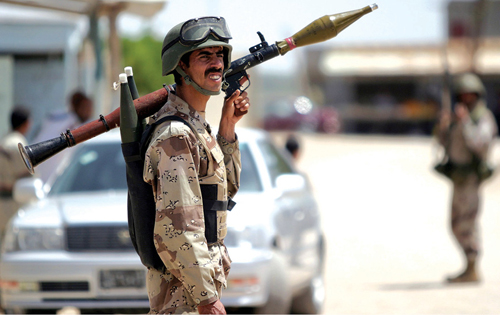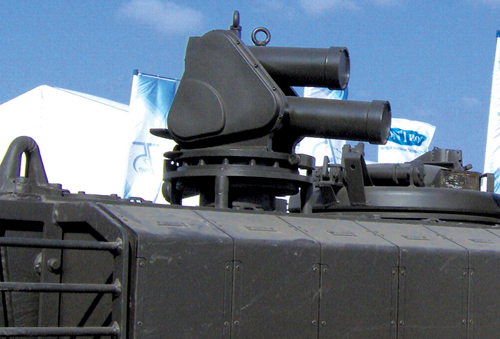To defeat wire-guided missiles, the SK-APS, uses a jammer. The jammer is a powerful IR flashlight that can also pulsate. The command-launcher console tracks the IR beacon of the missile to find the position of the missile. When the missile starts approaching the tank, the SK-APS computer activates the electro-optical jammers that start emitting IR pulses. The command-launcher console mistakes the jammer for missile’s IR beacon. Since jammer is an integral part of the tank, the command-launcher thinks that the missile is exactly on course, but in fact the missile is now off course. The missile therefore crashes somewhere other than the tank.
American AN/VLQ-6 missile countermeasures device, German muti-functional self-protection system and Russian Shtora are some of the predominant SK-APS systems in use.
Hard-kill active protection systems
A major handicap of an SK-APS is its inability to defeat anti-tank rockets. An anti-tank rocket, called rocket propelled grenade (RPG), is a dumb weapon without any electronic guidance system. So it cannot be confused. It just travels in a straight line like a bullet. Though dumb and cheap, it can effectively destroy millions of dollars worth tank. Hence it has become the favourite weapon of terrorists.
The changing geopolitics has led the battles to be fought in cities against terrorists and insurgents rather than in open terrains. This requires the tanks to prowl the streets, an unfavourable ground for tanks. Even a minimally trained person can take out a tank with an RPG from a roof-top. So narrow streets and gullies have now become tank-killing grounds. This has necessitated hard-kill systems to destroy these rockets. So far only Russia and Israel have had to fight intensely inside cities and faced the wrath of the RPGs. Forced by these conditions, only they have successfully deployed such systems to defeat the RPG menace. Developmental efforts are going on all over the world to develop such systems.


(Photograph credit: Ereshkigal1 through Wikipedia)
The HK-APS is a fully-automatic system providing a very high degree of protection for the tank in all climatic and terrain conditions. It can protect the tank from anti-tank rockets and missiles, and treats them the same way. It uses radar for detecting the incoming projectile missile or rocket. Then it uses interceptor rocket launchers instead of grenade launchers and jammers.
Multi-directional radar mounted on roof of the tank acts as eyes of the HK-APS and constantly scans for an approaching rocket. Depending on the type and design of the HK-APS, separate radars scanning different sectors may replace this multi-directional radar. The HK-APS computer filters the resultant radar echoes and culls out the echoes matching that of these RPGs.
Once the echo of an RPG is filtered and identified, the radar switches to the target-tracking mode. In this mode, it stops looking elsewhere and continuously looks at the projectile to derive the direction and bearing (trajectory) of the incoming RPG. This trajectory data is fed into the APS computer of the HK-APS.
If the computer finds that the trajectory of the projectile is towards the tank, it calculates the right time and angle to destroy the RPG. Once the RPG has reached the right area, the control computer activates the rocket launcher to fire a short-range interceptor rocket. This rocket, after reaching the proximity of the RPG, explodes and releases many fragments that in turn destroy the RPG. The same methodology applies for anti-tank missiles also.
The reaction time of these hard-kill active protection systems is generally in milliseconds after an RPG is detected. The RPG is intercepted within a blink of an eye. After destroying an RPG, the system gets ready to destroy the next projectile within half a second. In a separate interactive display, the tank commander sets the modes of operation and monitors status of the system. Even if a projectile passes without harming the tank, through this display the HK-APS indicates to the tank commander the direction from where it was fired. The tank commander may, in turn, attack that source of attack.
The design of these APS is such that they do not respond to decoys. The modern Russian HK-APS systems are rumoured to be even capable of working in a group with the APS of the adjacent tanks. But further details are kept as highly classified information. In general, how the APS distinguishes between different types of missiles and accordingly fixes its modus operandi are not revealed in the open domains.






